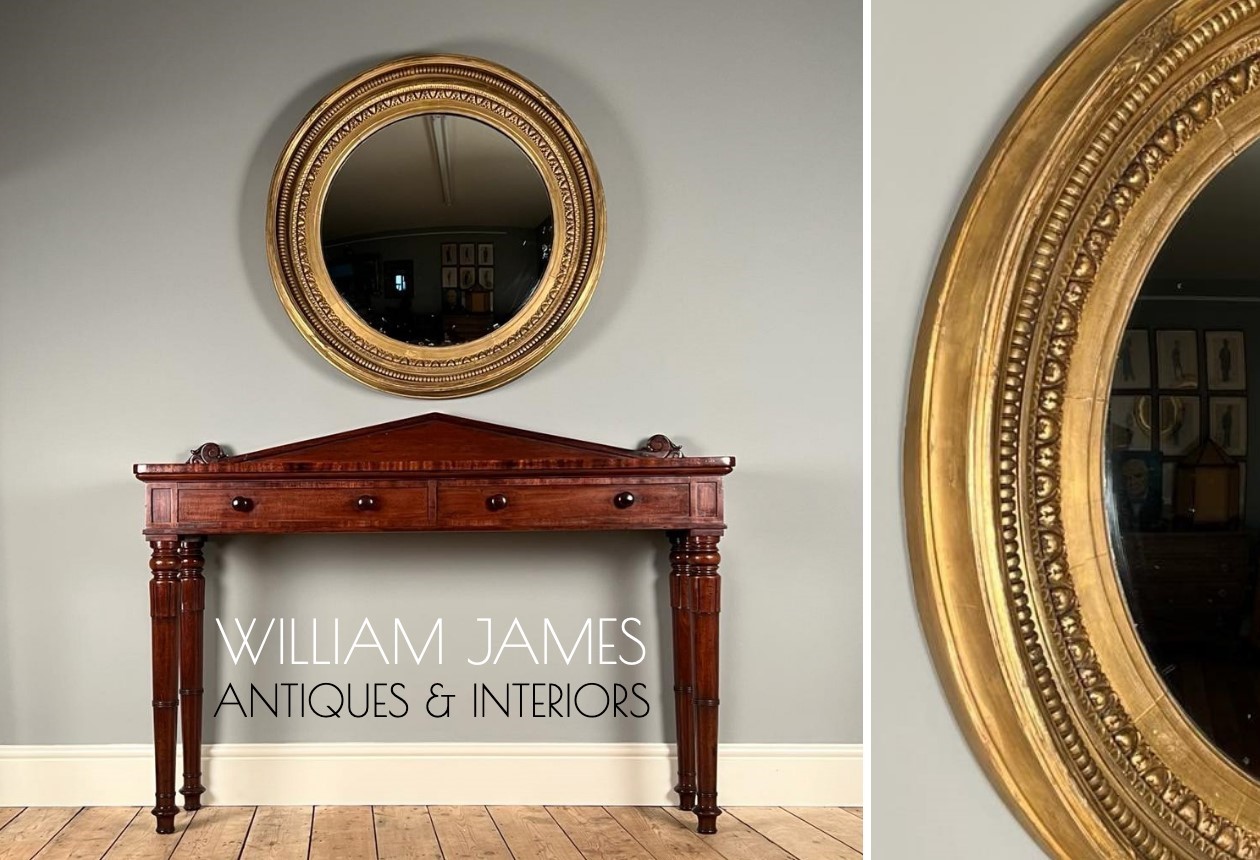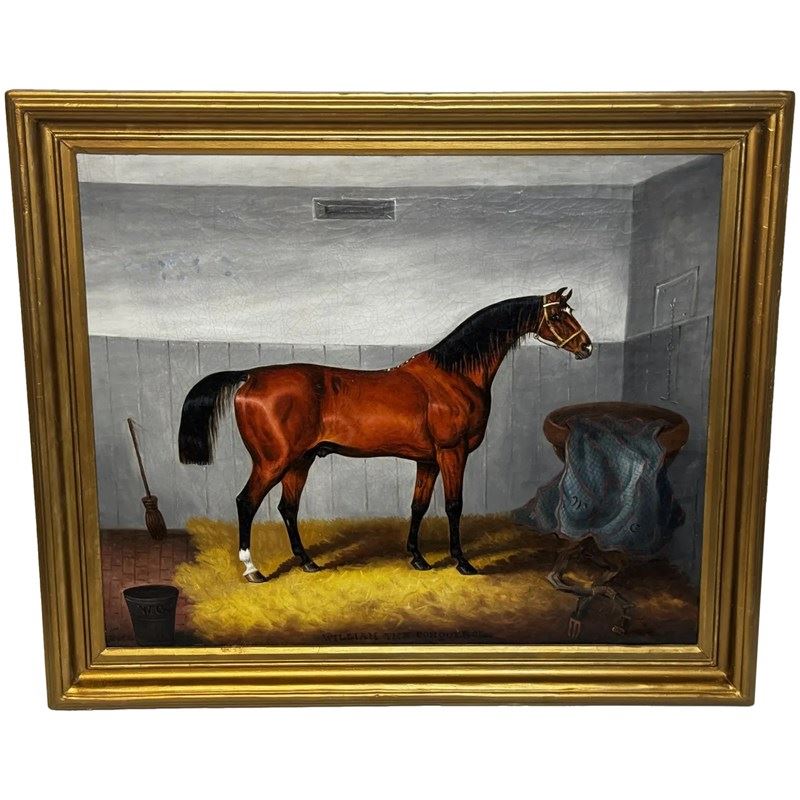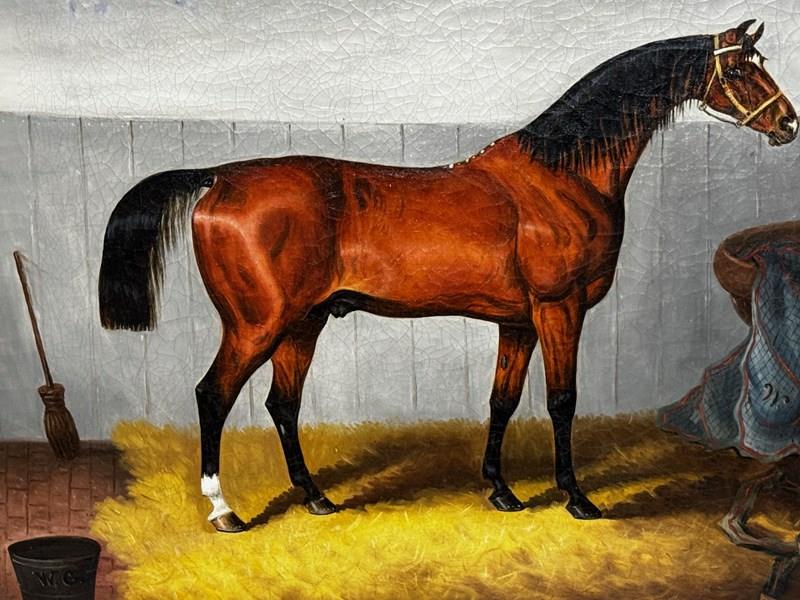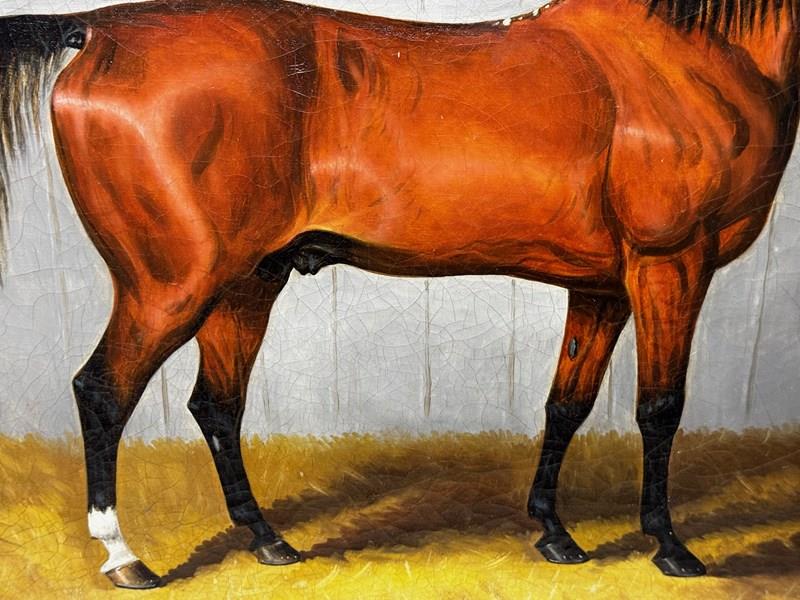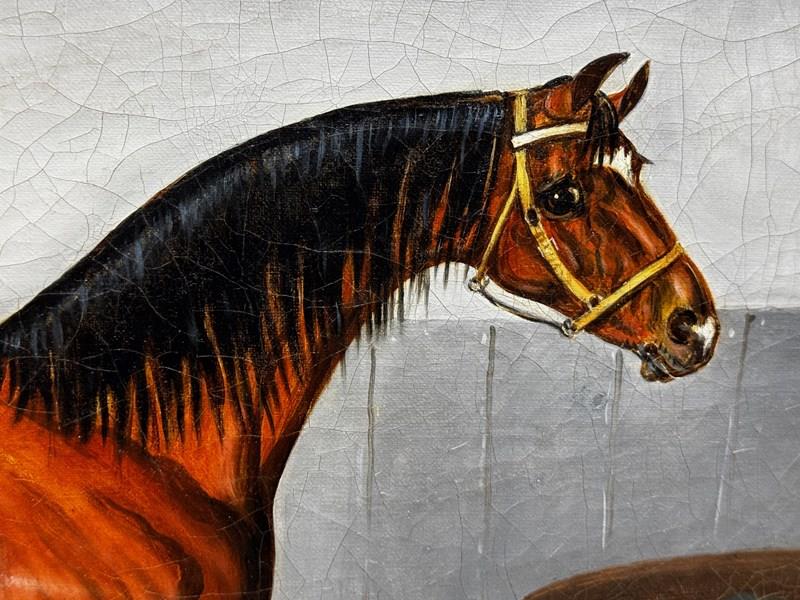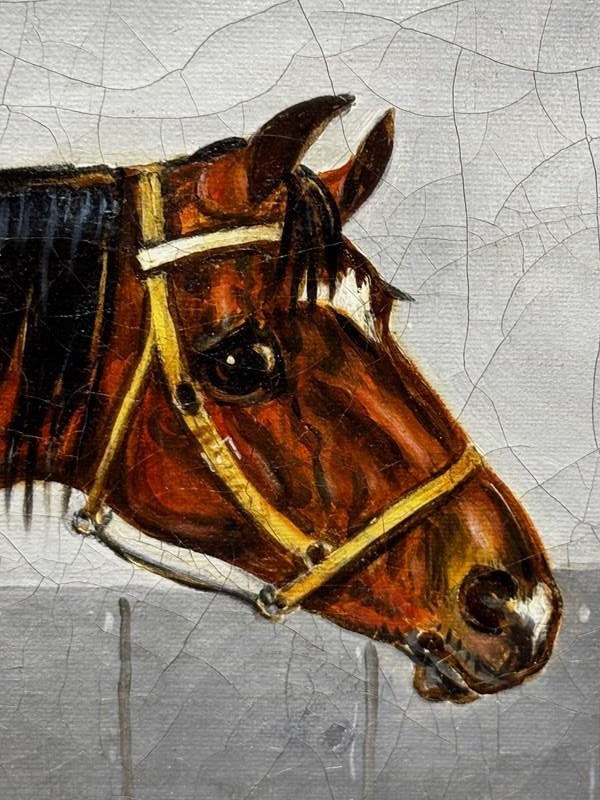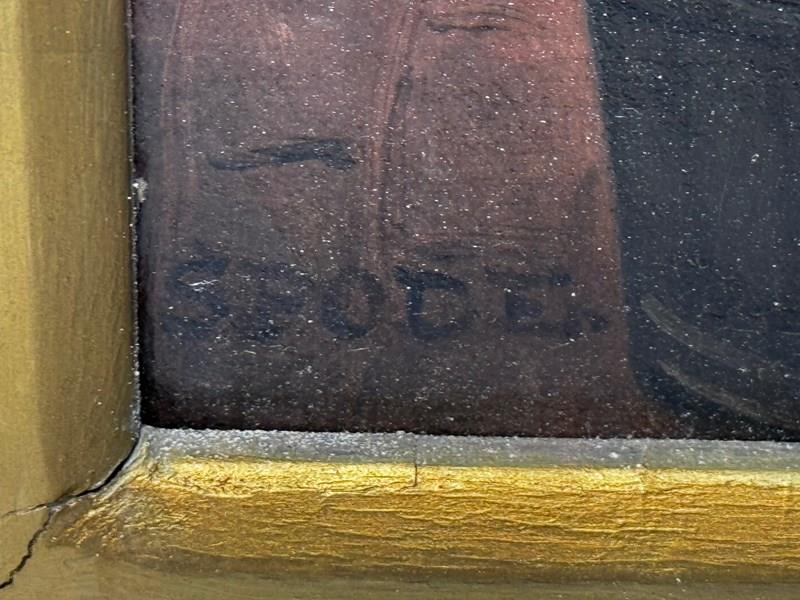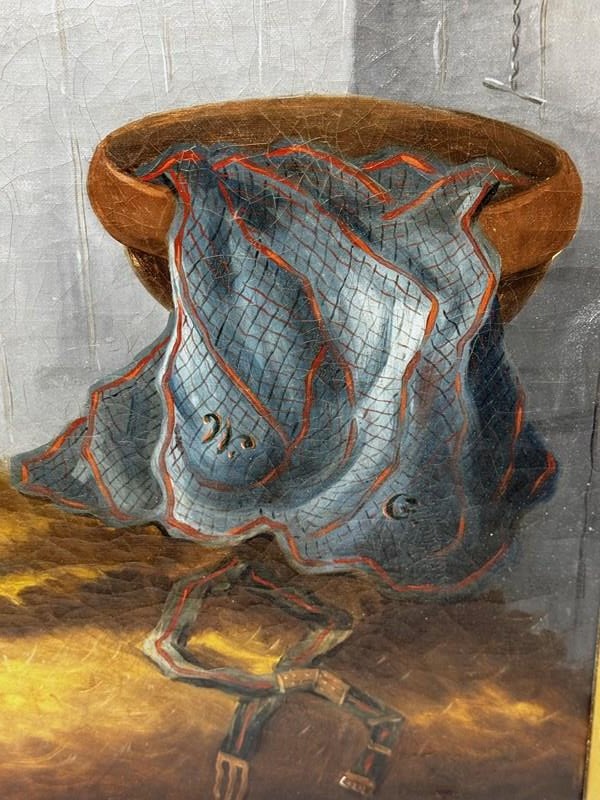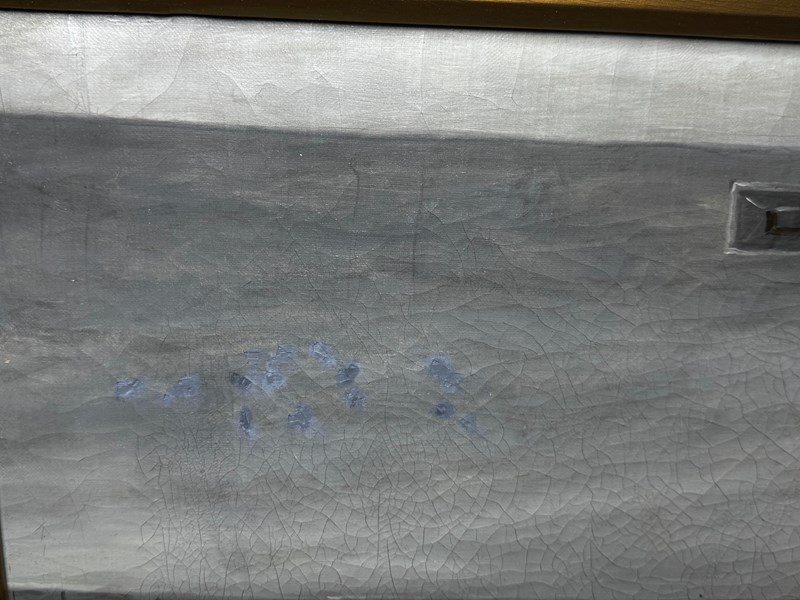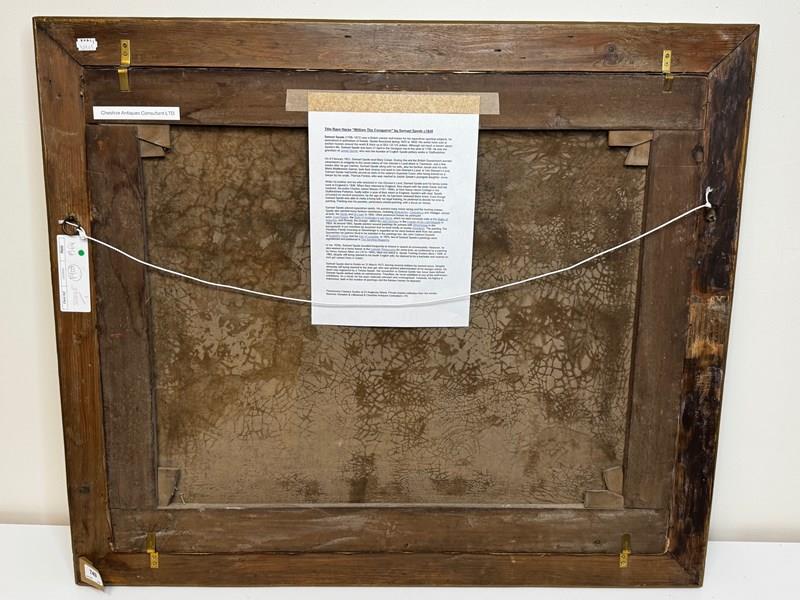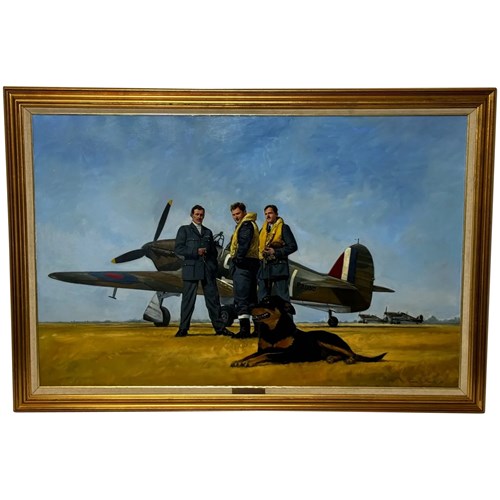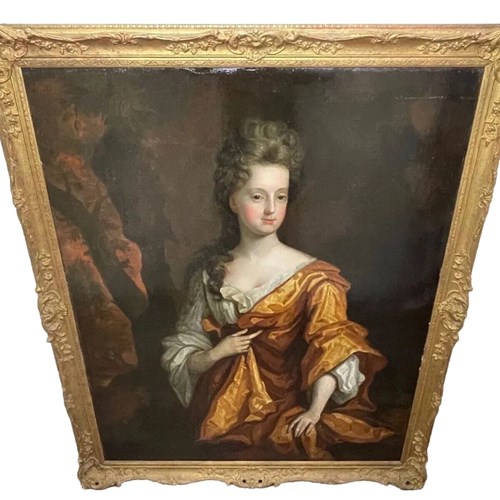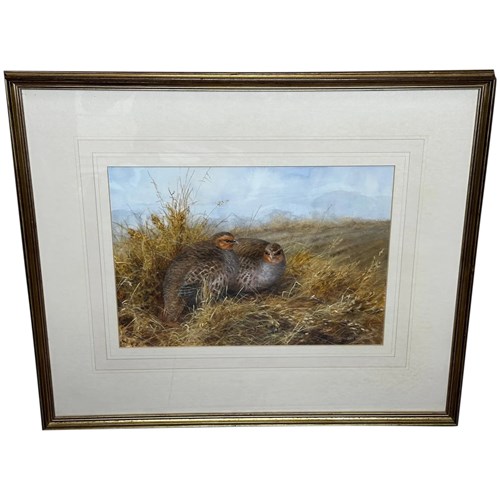Equine Painting Race Horse William The Conqueror In Stable By Samuel Spode
Stock No
CACL466
2023
- £10,000.00
- €12,083 Euro
- $12,644 US Dollar
Questions about this item?
Like this item?
Item Description
Sporting British Early Victorian 19th Century Oil Painting Portrait Gelding Race Horse William The Conqueror In Stable by Samuel Spode.
Impress your clients & guests with this equine horse racing historical masterpiece to display on your office or home wall space.
Subject Equine horse study portrait of a brown thoroughbred gelding racehorse facing right in full side profile. The horse is standing in his stable, having a black mane & tail, with white freckle spots along his upper back spinal ridgeline & he is wearing his bridle. You can see golden straw on the floor, and his turquoise tartan blanket showing his WC name initials is resting in the corner on a curved rack. To the lower left flank is a wooden water bucket also having the horse initials WC, further back resting on the stable wall is a wooden sweeping broom on a cobbled floor.
The details is so incredible of the horse with the muscle definition and the brown hue colours.
Title Race Horse “William The Conqueror” by Samuel Spode c1840.
Oil on canvas
Set in the original traditional gilt frame.
Circa 1840 early Victorian era.
This painting is signed in the bottom corner by the known British sporting portrait artist Spode, For Samuel Spode.
Inscribed with the race horse's name on the bottom.
in our opinion, this is one of his fine works.
Artist Biography Samuel Spode (1798–1872) was a British painter well known for his equestrian sporting subjects, he specialised in portraiture of horses. Spode flourished during 1825 to 1858. His works have sold at auction houses around the world & fetch up to $53,125 US dollars. Although not much is known about Spode's life. Samuel Spode was born 21 April in the Georgian era in the year of 1798. He was the grandson of Josiah Spode, who was the founder of English Spode pottery works in Staffordshire.
On 6 February 1821, Samuel Spode wed Mary Crewe. During this era the British Government wanted adventurers to emigrate to the penal colony of Van Diemen’s Land which is Tasmania. Just a few weeks after he got married, Samuel Spode along with his wife, also his brother Josiah and his wife Maria Middlemore Garner, took their chance and went to Van Diemen's Land. In Van Diemen's Land, Samuel Spode had briefly served as clerk of the colony's Supreme Court, after being trained as a lawyer by his uncle, Thomas Fenton, who was married to Josiah Spode's youngest daughter, Anne.
While his brother and his wife remained in Van Diemen's Land, Samuel Spode and his family came back to England in 1826. When they returned to England, they stayed with his sister Sarah and her husband, the potter Charles James Mason (1791–1856), at their house Heron Cottage in the Staffordshire Potteries. Sadly within a year of their return to England, Spode's wife died. Spode remarried on several occasions, by the age of 40, he had been widowed three times. Even though Samuel Spode was able to make a living with his legal training, he preferred to devote his time to painting. Painting was his passion, particularly animal painting, with a focus on horses.
Samuel Spode adored equestrian sports. He painted many horse racing and fox hunting scenes. Spode also painted many famous racehorses, including Birdcatcher, Caractacus and Voltager, winner of both: the Derby and St Leger in 1850. Other prominent horses he portrayed were Copenhagen, the Duke of Wellington's war horse, which he most famously rode at the Battle of Waterloo, and Ronald, the charger, ridden by Lord Cardigan in the Charge of the Light Brigade in 1854. At around 1845, Spode painted several paintings for patrons with Stonehenge in the background. It can therefore be assumed that he lived briefly at nearby Amesbury. The painting The Pinckney Family Coursing at Stonehenge is regarded as his most famous work from this period. Sometimes his patrons liked to be included in the paintings too, like John Dawson Duckett of Duckett's Grove and the Earl of Lonsdale. In 1825, two of Samuel Spode's paintings were reproduced and published in The Sporting Magazine.
In the 1830s, Samuel Spode travelled frequently to Ireland in search of commissions. However, he also worked as a horse trainer at the Curragh Racecourse for some time, as evidenced by a painting by Henry Samuel Alken Jnr (1810–1894), titled and dated S. Spode Training Eastern Bere / 1856. In 1865, despite still being married to his fourth English wife, he claimed to be a bachelor and married an Irish girl named Delia in Dublin.
Samuel Spode died in Dublin on 31 March 1872, leaving several children by several wives. Despite obviously still being married to the Irish girl, who was granted administration of his meagre estate, his death was registered by a Teresa Spode. Her connection to Samuel Spode has never been defined. Samuel Spode worked solely on commissions. Therefore, he never exhibited at any of the well-known exhibitions. As a result, he has been relatively unknown and unrecognised. However, his legacy is impressive, both in the number of paintings and the famous horses he depicted.
International worldwide shipping is available please ask for a quote.
Provenance label verso for framers Smiths of 23 Anglesea Street, Private Equine collection from the vendor, high-end south-west based auction house & in collection of Cheshire Antiques Consultant LTD
We only select & sell paintings based upon subject, quality & significance.
We provide friendly professional exceptional customer service.
With hanging thread on the back ready for immediate home display.
Condition report offered in fine used condition. Painting surface in overall acceptable order, having various foxing stains craquelure to the surface, with some noticeable paint touch-ups to the background area & paint flaking in places. Canvas is unlined & the frame is original & has been overpainted along with having general wear, scuffs, cracking & some losses also repairs commensurate with usage & old age.
Viewings are welcome by appointment only for customer support please send a message thankyou.
Browse our exciting other available fine arts, antiques & collectibles in our gallery.
Dimensions in centimetres of frame
High (76 cm)
Depth (4.5 cm)
Wide (88.5 cm)
Item Info
Seller Location
Covent Garden, London
Item Dimensions
H: 76cm W: 88.5cm D: 4.5cm
Period
1840
Item Location
United Kingdom
Seller Location
Covent Garden, London
Item Location
United Kingdom
Seller Contact No
+44 (0)7494 763382
More from CHESHIRE ANTIQUES CONSULTANT LTD
